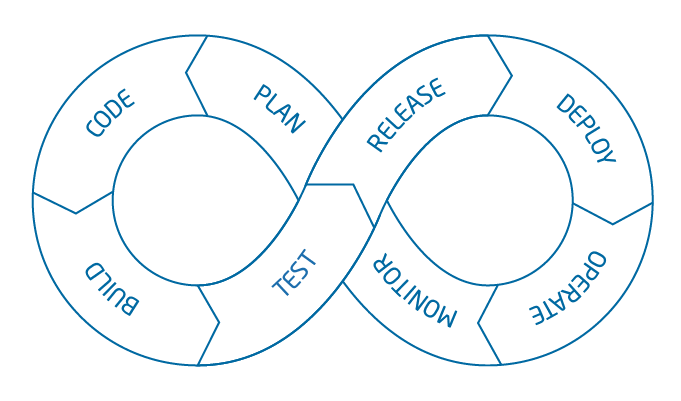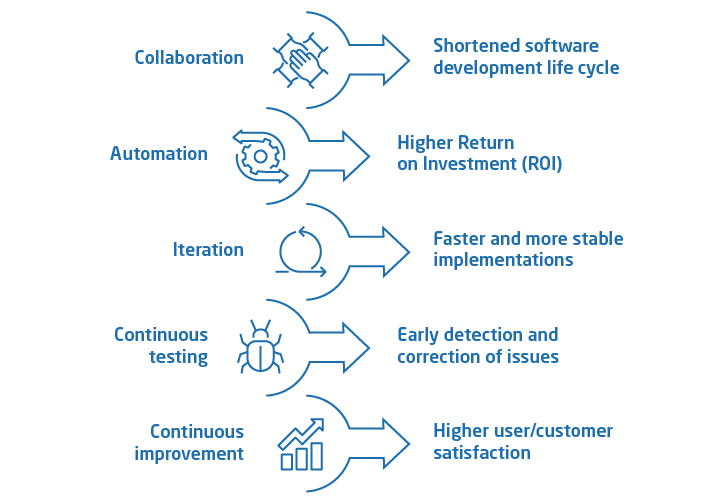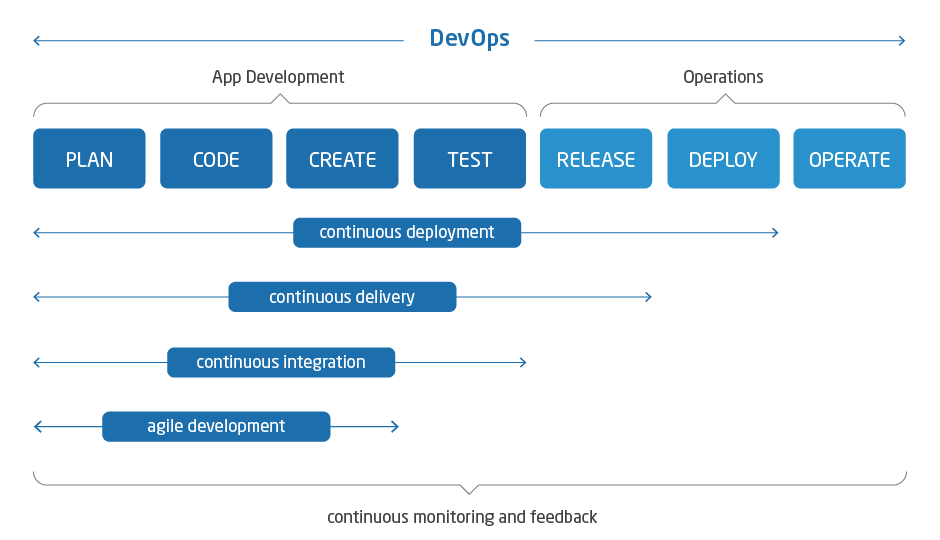More effective delivery
According to State of DevOps Report, results achieved by DevOps teams are very impressive in comparison to teams using other methodologies:
Achieving such results is possible thanks to collaboration and combining competences from Dev and Ops areas in development life cycle characteristic for this methodology.

DevOps software development life cycle
Key assumptions
The key DevOps assumptions are as follows:
- Automation: workflow, testing of new code, and infrastructure delivery automation to maximize productivity.
- Iteration: writing small portions of code as part of a sprint to increase the seed, stability, and frequency of deployments.
- Continuous testing and improvement: continuous search of room for product and processes improvement as well as responding to feedback in order to optimize the efficiency, costs and deployment time.
- Collaboration: close interaction of teams, communication improvement, combining together such IT areas as development and QA.
DevOps – principles and benefits
DevOps approach significantly contributes to increasing the quality of software. Through implementing its key principles, we successfully carry out hundreds of IT projects, helping organizations gain tangible benefits.

Three pillars of automation
DevOps methodology puts Agile, cooperation of teams and process automation at its core, supported by three pillars.
| Infrastructre as code (IaC) | Deployment automation | Monitoring and security |
| Defining the whole environment as code – configuration and launching. Automatic management and deployment of environments through scripts. | Continuous integration, continuous delivery, continuous deployment – instant deployment to test or production environments. Full test automation, continuous testing in both test and production environments. | Focus on the quality of code – full automation of monitoring to increase security. Developing simple tools reflecting the state of a system in a given moment and automation of security tests. |
Comprehensive support
DevOps-driven software development life cycle includes:
- Continuous development – a strategy that allows quicker delivery of new features or products of higher quality, minimizing the risk at the same time.
- Continuous testing – allows developers to ensure that the code actually works as it should. Helps detect bugs and identify all areas of a product that need correcting or enhancing.
- Continuous integration – helps preventing costly delays in development allowing developers to work on the same source code.
- Continuous delivery – allows releasing software updates to users in an efficient and balanced manner.
- Continuous monitoring and feedback – allows IT departments to identify issues in the real time and notify developers about them, which enables agile response and translates into the increase of security and reliability of the system.
- Continuous deployment – smaller and more frequent software releases allow developers to quickly receive feedback from users, developing a better product as a result.

DevOps flow process
Maximizing productivity
According to the Ringlemann effect, the individual productivity of a team member decreases as the size of the team increases. This is why, in the DevOps methodology, Jeff Bezos’ two-pizza rule is used – a team should be small enough, so its members could be fed with two large pizzas during the meeting.
How we maximize our productivity step by step:
- By reducing the number of people in a team: we build small self-organizing teams to improve communication, provide decision-making autonomy, and increase control over work.
- By continuously perfecting the product and processes: we practise Continuous Improvement rules to boost productivity and adapt to new business circumstances.
- By investing in appropriate collaboration tools: we utilize solutions that allow current progress tracking, version and release control as well as supporting team communication.
- By increasing the effectiveness of meetings: we use Scrum meetings to maximize the focus on the goal, decrease the time needed for meetings and their costs.
Summary
DevOps approach lets us better respond to our clients’ needs, increase the stability of created solutions, and execute business goals much quicker.
To achieve established goals, we carry out all projects using verified and recommended methods and practices, according to client requirements and needs.